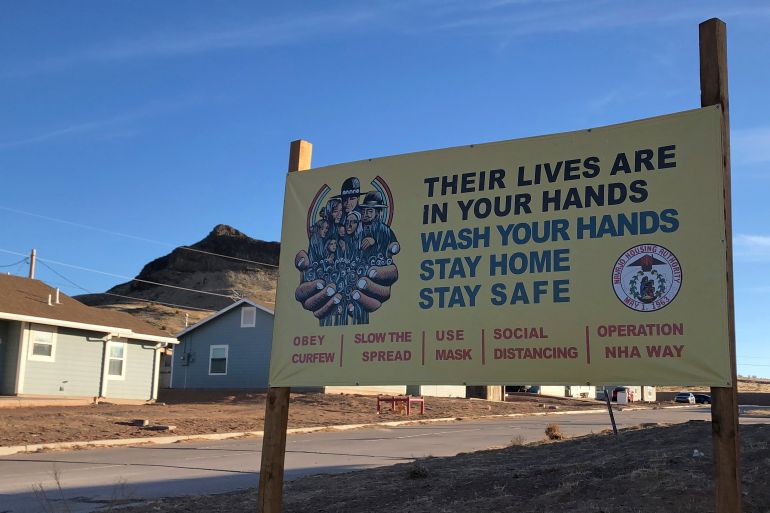Navajo Nation outpaces wider US: 60 percent fully vaccinated
Navajo Nation leads the US in vaccination rates, despite rural population, by meeting people ‘where they are’.

The Navajo Nation continues to lead the United States in vaccination efforts, having fully vaccinated 102,372 individuals as of May 15 – 60 percent of the tribal lands’ population of roughly 170,000 – according to data released on Thursday.
By comparison, the US has fully vaccinated 37.8 percent of its population as of May 19, according to Centers for Disease Control and Prevention (CDC) data. The US state with the highest percentage, Maine, sits at 50 percent fully vaccinated.
Keep reading
list of 3 itemsNavajo Nation outpaces much of US in delivering COVID vaccines
Navajo Nation forecasts ‘community immunity’: 120,000 jabs given
The Navajo Nation, which encompasses an area larger than West Virginia across four states that effectively serves as a reservation, reached this feat roughly six months after vaccine distribution began.
It did so with a hard-to-reach rural population that tends to be elderly, according to figures from the Navajo Housing Authority (PDF).

President Joe Biden, who has made the COVID-19 the defining issue of his early presidency, has set a goal of 70 percent fully vaccinated by July 4.
Biden has placed importance on distributing the vaccine to rural populations, whose vaccination rates have lagged behind urban populations, as key to reaching the goal.
Success through adaptation
Dr Loretta Christensen, acting chief medical officer of the Indian Health Service (IHS) who is also the chief medical officer for IHS operations on the Navajo Nation (NAIHS), told Al Jazeera the success came through adaptability.
The Navajo Nation has been at the forefront of vaccine distribution methods. NAIHS personnel and volunteers have staffed vaccination sites, including drive-thrus, for hours-long shifts during the past six months.
TODAY AT MONUMENT VALLEY HIGH SCHOOL – COVID-19 VACCINES AVAILABLE
Monument Valley High School
Nash Center Parking Lot, Kayenta, AZ
Tuesday, May, 18th
Wednesday, May 19th
9:00 AM – 3:00 PM
For individuals 12 years and olderFor more information, please call (928) 697-5170. pic.twitter.com/YTKj2v4fPV
— Navajo Nation President Jonathan Nez (@NNPrezNez) May 18, 2021
But they “re-strategise all the time”, Christensen said, detailing weekly meetings to discuss what is working about their strategy and what could be improved.
“What I think is really unique is we have strike teams made up of our public health nursing … and community health representatives from the tribes” who know the people in rural areas, Christensen said.
They know who is “homebound, who’s disabled, who can’t get to a facility”.
The community knowledge of these officials allows for health officials to “go out and give them vaccinations. We will do the whole family. We will do their caregivers. We will take care of all that on a single trip to that home.”
The pandemic severely affected the tribal area last year, with cases surpassing that of New York state last May. Now, the seven-day average of cases dropped from its peak of 250 on November 26 to 13 on May 15.
Wider tribal success
The Navajo Nation has received attention for the steep drop in cases thanks to its vaccination efforts, but it is not the only Indigenous area to enjoy success in dealing with the pandemic.
“According to the CDC’s recent report on the percentage of people fully vaccinated by racial groups, Native peoples have the highest percentage of fully vaccinated people”, Crystal Echo Hawk, founder and executive director of IllumiNative, an Indigenous-led group that aims to increase visibility for Native nations, told Al Jazeera.
The Indigenous have also shared their resources to help fight COVID-19, Echo Hawk noted.
“Tribal communities like the Blackfeet Tribe in Montana, and Chickasaw Nation and other tribes in Oklahoma, expanded access to vaccines to non-Natives before the vaccine was widely available.”
The successes are due in part to the urgency felt by Indigenous communities, who were disproportionately affected by the pandemic, but also cultural values.
A January survey by the Urban Indian Health Institute found that 74 percent of respondents viewed getting vaccinated as a personal responsibility for their communities.
“Native peoples are choosing to get vaccinated to protect and care for our community – something that is deeply ingrained in our Indigenous values. Native leadership and Native-led solutions are critical, it’s time that this country prioritises bringing more Native leaders to the table”, Echo Hawk concluded.
Christensen said Navajo health officials are “always happy to share our information” with other communities, “but … it is really very specific to your population and the best approach is to meet your people where they are.”
On May 13, the Navajo Nation began vaccinating minors aged 12 to 15, the day after the CDC approved its use in that age group.
Christensen said the NAIHS is adapting its approach relative to the needs of children, including encouraging entire families to come for vaccines and “different media that the kids that age will look at”.
She is “proud” of the vaccination effort on the Navajo Nation but Christensen gives “the credit to the Navajo people”.
Christensen concluded, “They listened, they stepped up and they stood in line.”